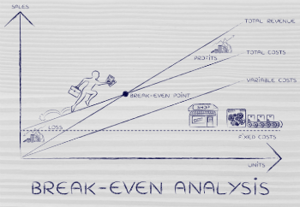Break Even and Beyond – Why You Need a Cash Flow Forecast
 Young and growing businesses rarely turn a profit – let alone manage to break even – right out of the gate. In fact, when we look beyond the estimated 50% failure rate for small businesses in their first five years, we find that it can still take the average surviving business several years to become profitable.
Young and growing businesses rarely turn a profit – let alone manage to break even – right out of the gate. In fact, when we look beyond the estimated 50% failure rate for small businesses in their first five years, we find that it can still take the average surviving business several years to become profitable.
There are many good reasons why you should be working with cash flow forecasts, not the least of which is that they ensure your business will continue to be able to pay suppliers, employees, and creditors over the short term. But one important cash projection benefit that’s often overlooked is the way they can help companies figure out when they might expect to reach their break-even point.
Profitable on Paper, Cash-Poor In-Pocket
Sales are flourishing, new customers are lined up outside the door – but for some reason, there’s more cash flowing out of your business than there is flowing in. What’s going on?
The fact is that there’s some truth to the old saying that you have to spend money to make money. And many up and coming companies face the dilemma of having to fund initial and ongoing expenses before income starts to materialize – especially if they deal in credit-based sales.
Consider some of the many expenditures your business probably covers on a regular basis:
- Vendor and administrative supplies,
- Rent for office or warehouse space,
- Wages or salaries for yourself and your staff,
- Utilities, insurance, and taxes
- Loan payments, interest, and financing fees
These fixed expenses are just that – set costs that must be met, regardless of the state of your bank account. And since the collection of receivables tends to lag well behind customer sales, it’s easy to see why many business owners struggle to juggle their cash flow.
The chilling reality is that an organization can wrap up its fiscal year with a solid profit on the books, but still find itself strapped for cash. If you neglect to take advantage of financial forecasting to budget and plan for success, your business runs the risk of failure despite a steady increase in sales.
What’s Your Business’s Break-Even Point?
Creating accurate forecasts can help you stay in business while you wait for paper profits to become a reality. Because it predicts the timing and amount of business income and expenses over the course of a specific accounting period (usually one year), a cash flow forecast can - among other things:
- highlight if and when you may need to borrow funds to bridge a low-income gap, and
- illustrate where you may be able to adjust operations to reduce your expenses
But this informed and educated guess also plays a key role in determining your company’s break-even point: the point at which your revenue equals the costs associated with its generation. Once you know the many costs associated with running your business, you can use them to project when you’re likely to break even, and when you might actually turn a profit.
|
Do you know your business's break-even point? Your books may be holding you back from knowing. Get a free analysis to find out. |
A break-even analysis leverages data about both your firm’s fixed expenses, as discussed earlier, AND those expenses that vary in proportion to the volume of goods or services you provide. Examples of variable costs include direct labor, raw materials, sales commissions, and direct utility costs.
Calculating your break-even point is a valuable way to:
- analyze how much you need to generate in sales to cover your expenses,
- understand the timing behind getting paid vs paying your own bills, and
- monitor your company’s financial health
Reaching your break-even point essentially means: the total of your fixed and variable expenses is equal to your sales revenue, your cash flow is neither positive nor negative, and your profit is zero. It’s also your organization’s first step toward actually making money.
Getting the Most from Your Cash Flow Forecast
Remember, a cash flow forecast is no more than an estimate. But you can make yours as accurate and useful as possible by working with real-time data. Refer to your company’s financial records for historic sales and expense figures most likely to represent what you can expect going forward.
It can be challenging to predict the demand for a new product or service. So younger companies often turn to industry norms, local trends, and their competitors for information that will help them to forecast their sales. Working with an accounting professional who has experience in your field is another great way to access relevant data.
Bear in mind as you create your cash flow projection that it helps to expect the unexpected. Build in a cash cushion to cover unplanned expenses or a downturn in sales, and take steps to guard against financial weak spots revealed by your forecast. Finally, don’t be afraid to delay growth initiatives, secure a loan or line of credit, or pursue capital investment if that’s what it takes to tide your business over until it moves beyond the break-even point.


Comments